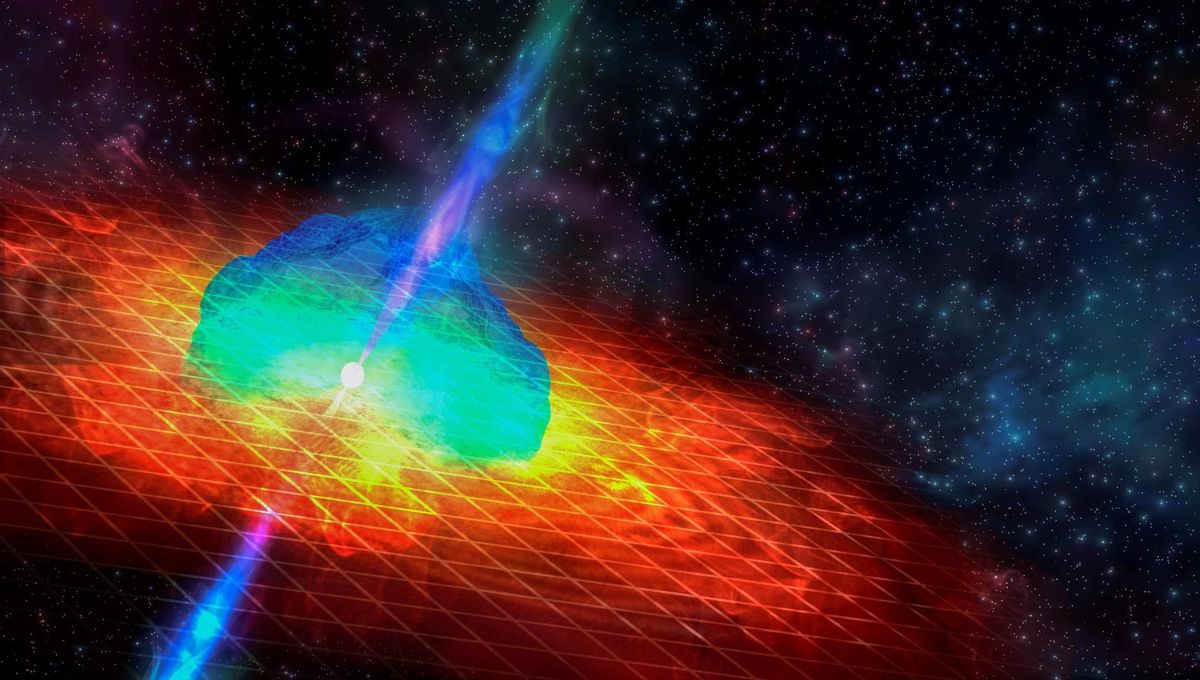
An exceptional explosion 1.3 billion light years from Earth produced enough heavy metals to outweigh all the planets, moons, and asteroids in the Solar System combined, just from the scarcest elements in the universe. Despite the rarity of the event, the production of precious metals and other rarities was so great that these events could account for a substantial portion of their abundance.
In 2021, a merger of two compact objects, known as a kilonova, was spotted by Neil Gehrels Swift Observatory and designated GRB 211211A. It was the closest example of this rare astronomical event that we have detected without gravitational waves. GRB 211211A was unusual because the gamma-ray burst (GRB) it produced lasted for a minute, a time period that has previously always been associated with GRBs from supernovas, rather than the merging of neutron stars.
Four papers were published together announcing the discovery and attempting to tease out the processes that could cause such an unusual event. To non-physicists however, the most interesting part is probably the astonishing quantity of heavy elements, including precious metals such as gold and platinum, produced. Nor is this just an explosion with the Midas touch, lots of more obscure, but very useful, elements such as the rare earth elements powering the energy transition, are made this way too.
Dr Matt Nicholl, then at the University of Birmingham, said in a statement: “We found that this one event produced about 1,000 times the mass of the Earth in very heavy elements. This supports the idea that these kilonovae are the main factories of gold in the Universe.” Considering that these elements make up only a tiny proportion of the Earth and other objects in the Solar System, you could seed a phenomenal number of planets from this explosion alone.
Ordinary stars fuse hydrogen into helium, and then helium into other elements during the course of their lives. As they die, low-mass stars produce some new ingredients, but most elements require more dramatic means of production. Elements like aluminum and potassium are formed in supernovas, but astronomers had come to suspect there might be another source for heavier elements since the number of supernova we see doesn’t match their abundance.
The first observation of a kilonova in 2017 helped address that, revealing that when neutron stars combine, the energy released causes the formation of much larger quantities of heavy elements than supernovas. Although kilonovas are much rarer than supernovas, they produce so much more of certain heavy elements that they account for most of these heavier metals’ presence in the universe.
If a typical kilonova produces a lot of elements like iridium and uranium, imagine what one with such a long legacy does. “Our fitting indicates a total r-process ejecta mass of …0.047 [solar masses],” Nicholl and colleagues wrote. “This includes approximately 0.02 [solar masses] of lanthanide-rich (‘red’) ejecta.” Those might not sound like much. However, consider that the Sun has 330,000 times the mass of the Earth, and 99.5 percent of the Earth’s crust is composed of elements no heavier than iron, and the scale of this “cosmic gold factory” starts to take shape. (To be fair, there are more heavy elements in the Earth’s core.)
To know what contribution events like GRB 211211A make to the presence of heavy elements in the universe we’d need to know how common they are, which is hard to tell from one example. Other long GRBs have been detected without an accompanying supernova, but we can’t be sure kilonovas were the cause.
It would help to know what caused GRB 211211A, something astronomers are still exploring. There is confidence the GRB was driven by the release of a jet of electrons traveling close to the speed of light, whose cooling triggered the release of gamma rays. That, however, just moves the question one stage upstream to what would produce such a powerful jet. One proposal is a neutron star-white dwarf merger, rather than the usual two neutron stars, but for the moment the question is unsettled.
The paper is published in Nature and is one of a set published together.
Source Link: "Cosmic Gold Factory" Kilonova Forged 1,000 Earths Worth Of Heavy Metals